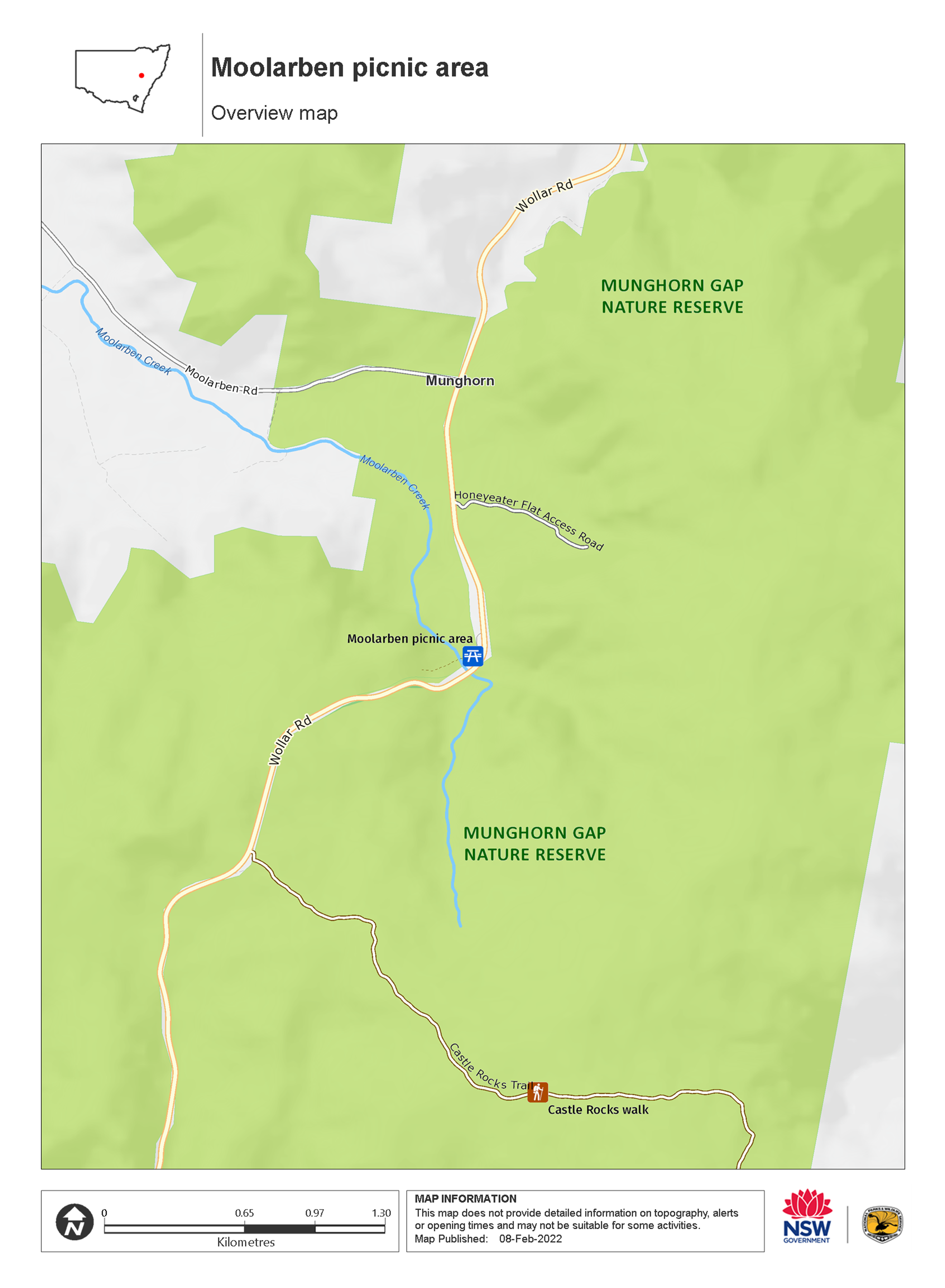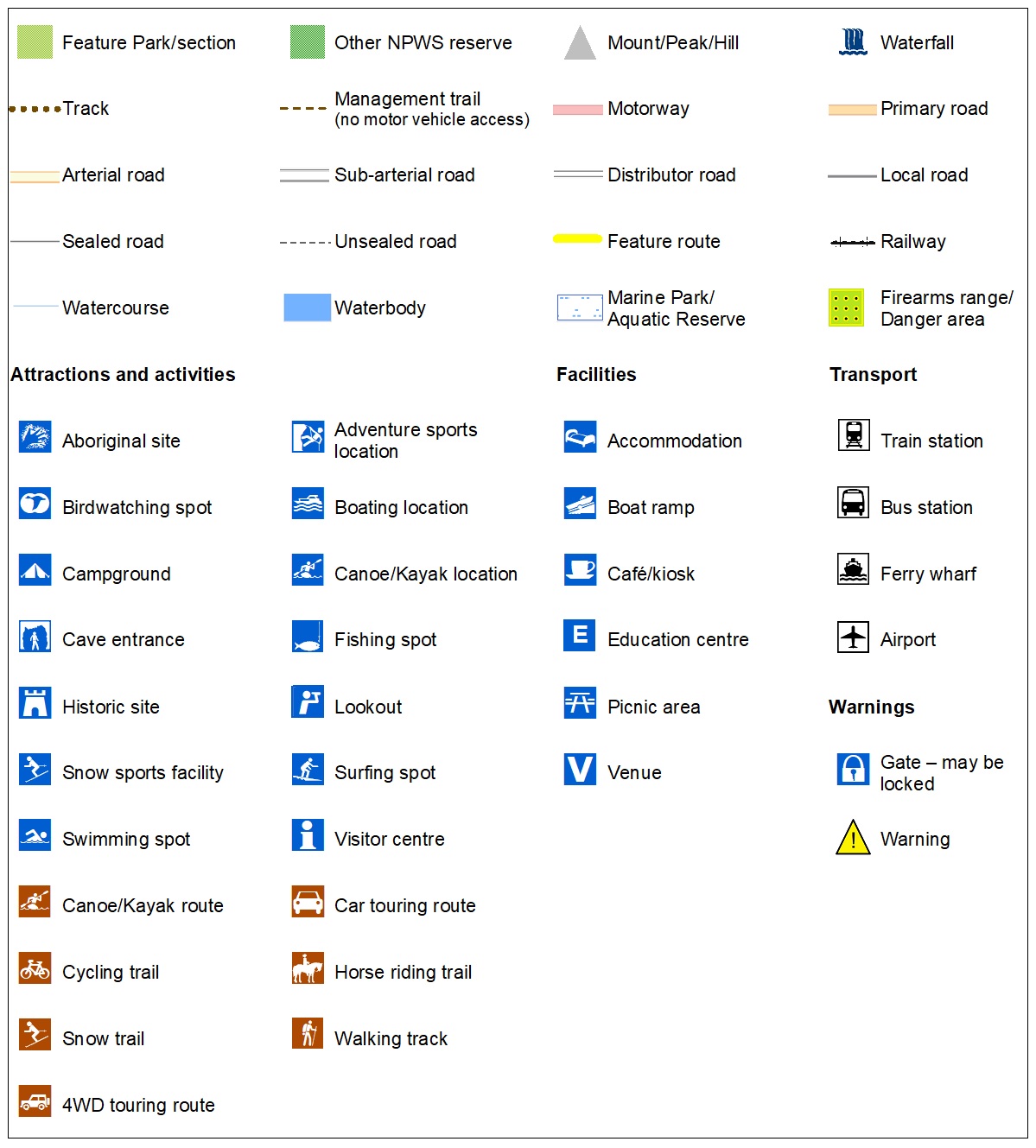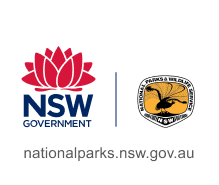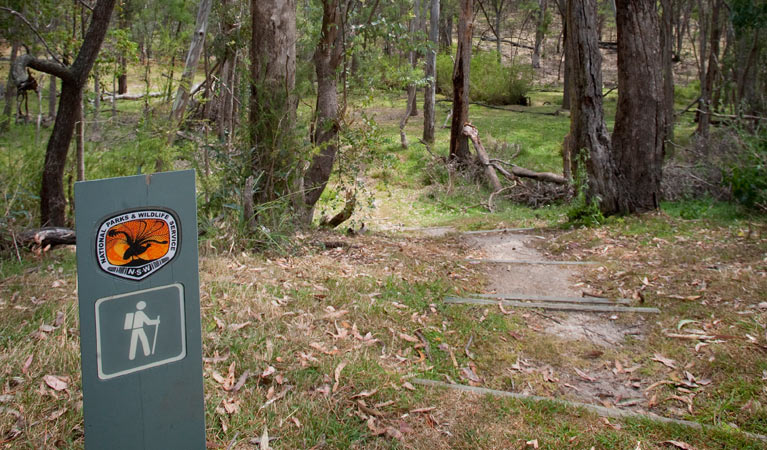Overview
Moolarben picnic area, at Munghorn Gap Nature Reserve, is a great place to picnic, barbecue and relax. Enjoy light hiking? Castle Rocks walk is close by.
- Type
- Picnic areas
- Where
- Munghorn Gap Nature Reserve in Country NSW
- Accessibility
- Easy
- Please note
- There is limited mobile reception in this reserve.
Set among eucalypts and native apple, Moolarben picnic area is a grassy, shaded spot within Munghorn Gap Nature Reserve. Come and enjoy a barbecue with family, friends, your bushwalking club, or fellow birdwatching fans. Look out for birds and animals around Moolarben, such as eastern grey kangaroos, emus, red neck wallabies and, if you’re lucky, an endangered regent honeyeater. Keep those binoculars close.
Over 160 species of birds have been recorded in the reserve and you don’t need to go far to see or hear them. Look out for a colourful flash of lorikeet, parrot or rosella, which are common to this area.
Access to Castle Rocks walk is nearby, so it’s easy to take a hike with a view either before or after your barbecue. This easy 8km walk offers fabulous views of sandstone pagoda features. You’ll definitely want to take your camera along.
Map

Map legend

Local alerts
For the latest updates on fires, closures and other alerts in this area, see https://www.nationalparks.nsw.gov.au/things-to-do/picnic-areas/moolarben-picnic-area/local-alerts
General enquiries
- National Parks Contact Centre
- 7am to 7pm daily
- 1300 072 757 (13000 PARKS) for the cost of a local call within Australia excluding mobiles
- parks.info@environment.nsw.gov.au
Park info
- in Munghorn Gap Nature Reserve in the Country NSW region
Munghorn Gap Nature Reserve is always open but may have to close at times due to poor weather or fire danger.
Visitor info
All the practical information you need to know about the Moolarben picnic area.
Getting there and parking
On entering Munghorn Gap Nature Reserve, park at Moolarben picnic area.
Road quality
- Sealed roads
Vehicle access
- 2WD vehicles
Weather restrictions
- All weather
Parking
Parking is available in a hard-packed ground carpark at Moolarben picnic area.
Best times to visit
There are lots of great things waiting for you in Munghorn Gap Nature Reserve. Here are some of the highlights.
Spring
The heathland begins flowering in late winter and it really starts to hit its stride in early spring. This makes it a particularly great time for camping, birdwatching and hiking.
Weather, temperature and rainfall
Summer temperature
Average
16°C and 30°C
Highest recorded
43°C
Winter temperature
Average
3°C and 16°C
Lowest recorded
-7.2°C
Rainfall
Wettest month
January
Driest month
April
The area’s highest recorded rainfall in one day
134.3mm
Facilities
Drinking and cooking water is not available in this reserve, so it’s a good idea to bring your own.
Toilets
- Non-flush toilets
Picnic tables
Barbecue facilities
- Wood barbecues (bring your own firewood)
Step-free access
The picnic area is flat, with a hard-packed ground pathway that leads to and across Moolarben Creek. From the pathway, you'll need to cross over stretches of flat grass to reach the picnic area's facilities.
The pathway is step-free until it crosses the creek, where it has roughly 80 steps. People with reduced mobility may need assistance at the creek crossing.
- Step-free outdoor pathways
Maps and downloads
Accessibility
Disability access level - easy
Moolarben picnic area is flat, with a hard-packed ground pathway that leads to and across Moolarben Creek. From the pathway, you'll need to cross over stretches of flat grass to reach the picnic area's facilities.
- The pathway through the picnic area is step-free until it crosses the creek, where it has roughly 80 steps. People with reduced mobility may need assistance at the creek crossing.
- There are accessible picnic tables
- The non-flush toilets at the picnic area are not accessible or ambulant.
Prohibited
Pets
Pets and domestic animals (other than certified assistance animals) are not permitted. Find out which regional parks allow dog walking and see the pets in parks policy for more information.
Smoking
NSW national parks are no smoking areas.
Learn more
Moolarben picnic area is in Munghorn Gap Nature Reserve. Here are just some of the reasons why this park is special:
Back and forth

After Europeans settled in the region, Munghorn Gap became a route for horse and bullock teams connecting Wollar, Merriwa and Mudgee. Evidence of past blacksmithing, timber-cutting, peat and coal mining, prospecting, and quarrying can still be found in and around the reserve.
Birds of a feather

As far as birdwatchers are concerned, Munghorn Gap is a happening place to go twitching. Over 164 different species of birds inhabit the reserve either permanently or seasonally, and many of these are rare and uncommon. They come in all shapes and sizes, from Australia's tallest bird, the emu, to the country's smallest, the 8-9cm weebill. Many are brightly coloured, such as rare scarlet honeyeaters and flame robins, while others like jackie winters and tree martins are more subdued in appearance. Bowerbirds and lyrebirds can be seen in Munghorn Gap along with national favourites like kookaburras, magpies and galahs. Birds of prey include wedge-tailed eagles, whistling kites, collared sparrowhawks, peregrine falcons and brown goshawks. After dark the boobook and owls - powerful, barking, and barn -take over for the nightly hunt.
- Castle Rocks walk It’s an easy hike along Castle Rocks walk to the lookout for wonderful scenic views of the sandstone pagoda features found at Munghorn Gap Nature Reserve.
- Moolarben picnic area Moolarben picnic area, at Munghorn Gap Nature Reserve, is a great place to picnic, barbecue and relax. Enjoy light hiking? Castle Rocks walk is close by.
Let's get physical

Great Dividing Range stretches the length of Eastern Australia and creates an interface between the western plains and the mountains. Munghorn Gap is one of the lowest points of the range and lies on the extreme western edge of the Sydney-Bowen geological basin. Parts of the reserve drain into Cudgegong River and, in turn, the Macquarie River system.
- Castle Rocks walk It’s an easy hike along Castle Rocks walk to the lookout for wonderful scenic views of the sandstone pagoda features found at Munghorn Gap Nature Reserve.
Trading places

Munghorn Gap has been inhabited by Aboriginal people for over 12,000 years. Once a major trading route between the Blue Mountains and the plains, Munghorn Gap continues to be a significant place to local Wiradjuri people.

